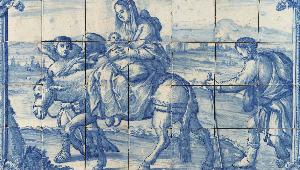Policarpo De Oliveira Bernardes (Attrib.)
Policarpo De Oliveira Bernardes (Attrib.);Policarpo De Oliveira Bernardes
Place: Lisbon
Born: 1695
Death: 1778
Biography:
Policarpo de Oliveira Bernardes was a Portuguese painter born in Lisbon in 1695 and died in 1778. He is known for his azulejos, traditional Portuguese tiles, and is considered one of the most important azulejos painters of the 18th century. As a son and disciple of António de Oliveira Bernardes, another important azulejos painter, Policarpo de Oliveira Bernardes's work was heavily influenced by his father's style.
Early Life and Training
Policarpo de Oliveira Bernardes was born into a family of artists and was trained in the art of azulejos from a young age. He learned the techniques of cuencas or aristas, which involved pressing a metal or wooden mould over the unbaked tile to create motifs. This technique, introduced by Italian potters in Seville, allowed for mass production of tiles with intricate designs.
Artistic Style and Notable Works
Policarpo de Oliveira Bernardes's azulejos are characterized by their vibrant colors and intricate patterns. His most famous works include the azulejos of the Church of São Lourenço de Almancil, the Church and Hospital of Misericórdia of Viana do Castelo, and the Church of St. Lourenço de Almancil. These works showcase his mastery of the azulejos technique and his ability to create beautiful, intricate designs. Azulejos are a form of Portuguese painted tin-glazed ceramic tilework that can be found on the interior and exterior of churches, palaces, and ordinary houses. They are an ornamental art form, but also had a specific functional capacity, like temperature control in homes. For more information on azulejos, visit the Wikioo.org page on The Romanticism Art Movement.
Influence and Legacy
Policarpo de Oliveira Bernardes's work had a significant influence on the development of azulejos in Portugal. His use of vibrant colors and intricate patterns helped to establish azulejos as a major aspect of Portuguese architecture. Today, his works can be found in museums and churches throughout Portugal, including the Museu Robinson College in Cambridge.
- Azulejo: A form of Portuguese painted tin-glazed ceramic tilework.
- Cuenca or Arista: A technique used to create motifs on tiles by pressing a metal or wooden mould over the unbaked tile.
- Church of São Lourenço de Almancil: One of Policarpo de Oliveira Bernardes's most famous works, featuring intricate azulejos designs.
For more information on Policarpo De Oliveira Bernardes (Attrib.), visit the Wikioo.org page. To learn more about azulejos, visit the Wikipedia page on Azulejo.

